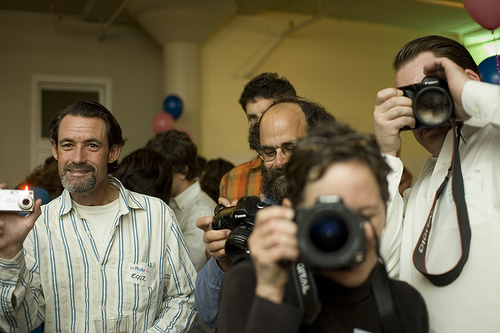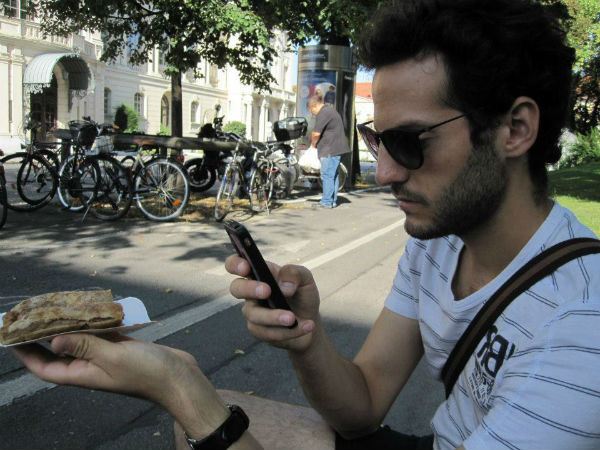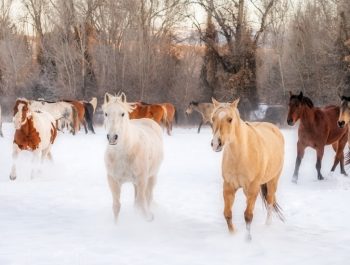Excessive-Compulsive Shutterbugs: Is Photography Replacing Reality?
Photographs share a fundamental sociological dynamic: the catalytic effect of photographs elicit and then collate stowed parcels of time exposing our past to rekindle memories from an enormous catalogue of life events.

Everyone is surfing on the digital photography wave, and why not, the entire process of taking photographs – from pressing the shutter release button to viewing an image – has become as easy as throwing a sealed container of frozen ingredients into a microwave oven and presto, dinner is served in a few seconds!
As a result, a worldwide subculture of picture-taking fanatics have taken post behind camera viewfinders and handheld device screens and seem to be hiding around every corner and behind every tree. Never mind the intrusion of “Big Brother” watching over the fictional dystopia superstate, Oceania, (depicted in George Orwell’s 1949 novel, Nineteen Eight-Four), present reality has everyone watching and capturing everyone else, and accepted as normalcy! Yes, it really is funny and actually quite amazing when we step back and view digital photography as a new dynamic influencing culture across the globe.
So yes, there is an overwhelming need to record everything from the lunch plate in front of me to cousin Sally’s dance rehearsal later that evening. A lot of images are snapped up every day, and many will be reviewed and deemed special enough to be uploaded to laptops and other more permanent residences in wait for post-production manipulation and storage for later viewing by family and friends.

Collectively, the catalog of hundred (and more likely, thousands of images; a result from the compelling habit of pressing and holding down the shutter-release button; a compulsion manifested out of the digital photography revolution, indeed) of pictures depicting family gatherings such as backyard birthday celebrations, snapshots of a newborn, a student celebrating his or her graduation, the rebellious teenager throwing rocks during a demonstration, documenting a do-it-yourself-project, or as simple as photographing a high-dollar dessert at an expensive restaurant, forming sentences and ultimately chapters in our lives that culminate into a final publication of life-long memories.
Photographs share a fundamental sociological dynamic: the catalytic effect of photographs elicit and then collate stowed parcels of time exposing our past to rekindle memories from an enormous catalog of life events. As time recedes, sometimes so do our memories. As a result, we lose the ability to reminisce about experiences we once held dear. Photographs provide a point of reference to assist in recall to provoke the subconscious collection of emotional diversities of our past into conscious heartfelt experiences.

It has always been my standpoint, one of the most effective means of enjoying the prolonged sense of time is to capture and then regularly view photos with family and friends, together with stimulating memories and experiencing the emotional journeys that result. “The thrill found in a photograph comes from the onrush of memory” (John Berger – Keeping a Rendezvous – Vintage 1992).
We still plan family events where I pull out the old slide projector – and more recently scanned slides presented off a 47-inch TV screen, as opposed to yesterday’s projections onto a silver screen. But whatever the method, watching each photographic image flash by, and with it a small piece of our history, never failed to bring incredible enjoyment. When these “slide shows” are shared with close friends and extended family the experience is – well, like living the event all over. We spend sometimes a quarter of an hour on a series of just three or four slides as the whole clan gets caught up in the details. Each participant is engaged in photo-elicitation: extracting specific memories and comments from each projected image – smells, taste, and light are relived creating a wonderful experience sometimes provoking extreme laughter or tears of sorrow.
Taking a break from our photographic devices – or photo-detox – as many have suggested, in an attempt to help us reengage the present, consequentially disengages our connection in preserving it. In my opinion, we do not consciously disengage the “now” when photographing a person, place or thing in hopes of experiencing it in the future. We photograph to experience the emotional impact these people or events gave us again and again long after the particular space and time has vanished.
This being said, we must remind ourselves to enjoy the actual event while it is happening. Fully experiencing the event in our present space and time is the essence of life. Missing out on wondrous moments are moments of lost memories to be shared with others in the future. Capturing these moments as a photographic image is only a tool to help us in the recall, and as such, should only serve as a supplemental to, and not a replacement for experiencing life in the present.
So, don’t pay mind to critics that suggest all you folks are excessive-compulsive and losing touch with reality. Keep on snapping away, recording life from behind trees, light posts, in front of grandma or baby Catharine, and by all means, the beautifully presented dinner the waiter just brought to your table. Societies have adopted the need to record life as part of their daily culture, and I think this is wonderful. And honestly, for all this need to record everything and everyone, perhaps a stronger cohesion between societies is developing as a result, creating a clearer focus of each other and our place in the cosmos.
Lance A. Lewin
September 2019
Atlanta, Georgia
For the most part, my inspiration from behind the viewfinder comes from a richly filled combination of studying the pioneers of photography in the mid to late 19th century and masters of the 20th century, (e.g., Julia Margret Cameron, Alfred Stieglitz, Ansel Adams, and Bob Kolbrener, for just four examples) while also studying art history, drawing and design, all in the pursuit of developing my own artistic narratives. Though a lot of my work cannot be deemed as “Straight Photography”, nonetheless, I stay clear of trends that can lead to what some refer to as hyper-reality and composite alternatives, instead, maintaining a photographic canvas that balances between modernist and pictorial aesthetics that evoke a sense of reality and authenticity. Current Projects: Currently, personal visual projects are focused in two areas of study: 1. interpretations of nature through the lens of Japanese aesthetics, and 2. a more specific interest in how people navigate around each other especially in a city environment: here my camera is pointed down or positioned close to the ground inviting the viewer to study this normally insipid perspective with renewed inquisitiveness. This change in perspective reveals the human impact and pace of everyday life; patterns we normally do not see in our hurried pace, as we stride from one place to the next. Glimpsing from one image to another reveals the bio-mechanical similarities in our stride, while unexpectedly exposing proof of our intimacy to each other as we dispense personal borders to walk near, around, and sometimes, seemingly through the people that surround us. Philosophy of Photography: Lastly, on the philosophical side of photography, I argue we have been witnessing a paradigm shift in how people approach and contemplate most photographic images they encounter: in this sense, spectators are aware technologies exist that can digitally manipulate image files (and including an increase in the use of AI based photographic software) thus giving the spectator pause in contemplating an images epistemic value. As such, my philosophical research is to eventually introduce alternative photographic categories in helping to differentiate between the wide scope of traditionally based photographic work and, for example, work that may be constructs of “composite” techniques or “conceptual” based photographic images, for two examples. Please, visit my website to learn a little more about my perspectives from behind the lens and teaching philosophy. http://visualizingart.com/ • Photographic Society of America (PSA) Global B&W Photography Mentor • PSA South Atlantic Area Membership Director • Contributing writer for PhotoPXL.com • International Visual Sociology Association (IVSA) North American & Canada Think Tank • Past Board Member at Gilmer Arts Gallery in Ellijay, Georgia • Past Photography Curator at Gilmer Arts Gallery in Ellijay, Georgia • Past Commissioner on the City of Kennesaw, Ga Art Counsel • Mayer School of Fashion & Design (the school no longer operates) • Continuing education at FIT (Pattern making and fabric technology) • Continuing education at Albany State University, Georgia (Art) • Retired Garment and Telecom industry Business Owner (40 years)







